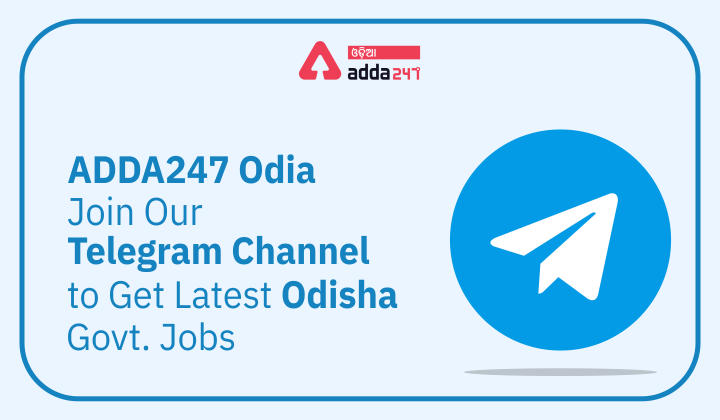History MCQs and Answers: History MCQs are very important for OPSC, OSSC, OSSSC & Other State Exams. Aspirants who are willing to apply for the various Government exams 2022 must go through the topics of History for competitive exams, as History is a key part of the syllabus.
Download ADDA247 Odia APP – Appear Latest Exam Test Series & Live Classes
Q1.When did Delhi become the capital of India?
(a) In 1910 AD
(b) In 1911 AD
(c) In 1916 AD
(d) In 1923 AD
S1.Ans(b)
Sol. In 1911, it was announced that the capital of British-held territories in India was to be transferred from Calcutta to Delhi. The name “New Delhi” was given in 1927, and the new capital was inaugurated on 13 February 1931.
Q2. Name the king who invaded Delhi and plundered the Kohinoor Diamond.
(a) Nadir Shah
(b) Firuz Shah
(c) Mohammed Shah
(d) Mohammed Ghori
S2. Ans.(a)
Sol. Aurangzeb’s death had created a void in the Mughal empire which none of his successors were able to fill. Frequent struggles for the throne and betrayal of ministers had resulted in the weakening of the empire. Nadir Shah, who from being a chief of dacoits had become the king of Persia, saw the weak empire as an opportunity. In 1738, Nadir Shah proceeded to invade India.
Q3. Razia Sultan, the first woman to sit on the throne of Delhi, was the daughter of Sultan
(a) Mohammed Ghori
(b) Mohammed of Ghazni
(c) Iltutmish
(d) Alauddin Khilji
S3. Ans.(c)
Sol.The fifth Mamluk dynasty ruler, history deems Razia Sultan as one of the very few female rulers in the history of Islamic civilizations across the world. During her reign, she ordered coins be minted with her title as “Pillar of Women, Queen of the Times, Sultan Razia, daughter of Shamsuddin Iltumish.”
Q4. The great silk-route was opened to the Indians by:
(a) Kanishka
(b) Ashoka
(c) Harsha
(d) Fa-Hien
S4. Ans.(a)
Sol. Kanishka I was the emperor of the Kushan dynasty in the second century (c. 127–150 CE). He is famous for his military, political, and spiritual achievements. A descendant of Kushan empire founder Kujula Kadphises, Kanishka came to rule an empire in Bactria extending from Turfan in the Tarim Basin to Pataliputra on the Gangetic plain. The main capital of his empire was located at Puruṣapura in Gandhara, with another major capital at Kapisa. His conquests and patronage of Buddhism played an important role in the development of the Silk Road, and the transmission of Mahayana Buddhism from Gandhara across the Karakoram range to China.
Q5. The paintings of Ajanta were inspired by?
(a) Compassionate Buddha
(b) Radha-Krishan Leela
(c) Jain Thirthankaras
(d) Mahabharata encounters
S5. Ans.(a)
Sol. The paintings in the Ajanta caves predominantly narrate the Jataka tales. These are Buddhist legends describing the previous births of the Buddha.

Q6. ‘Prithvirajraso’ was written by
(a) Bhavabhuti
(b) Jaideva
(c) Chand Bardai
(d) Banabhatta
S6. Ans.(c)
Sol. The Prithviraj Raso is a Brajbhasha epic poem about the life of the 12th-century Indian king Prithviraj Chauhan (c. 1166-1192 CE). It is attributed to Chand Bardai, who according to the text, was a court poet of the king.
Q7. The battle that led to the foundation of Muslim power in India was
(a) The first battle of Tarain
(b) The second battle of Tarain
(c) The first battle of Panipat
(d) The second battle of Panipat
S7.Ans.(b)
Sol. The Second Battle of Tarian (Taraori) was again fought between the Ghurid army of Mohammed Ghori and Rajput army of Prithviraj Chauhan. The battle took place in 1192 A.D near Tarain. In this battle, Prithviraj Chauhan was defeated by Mohammed Ghori.
Q8. The famous Kohinoor diamond was produced from one of the mines in
(a) Orissa
(b) Chhota Nagpur
(c) Bijapur
(d) Golconda
S8.Ans.(d)
Sol. The famous Koh-i-Noor (“mountain of light” in Persian) diamond weighs 105.60 cts and is considered one of the 5 priciest diamonds in the world was mined in Golconda, India.
Q9. Where is Gol Gumbaz, one of the largest dome in the world, situated?
(a) Damascus
(b) Istanbul
(c) Cairo
(d) Bijapur
S9. Ans.(d)
Sol. Constructed as per the Deccan architecture, Gol Gumbaz is the most important landmark of Bijapur, Karnataka.
Q10. The remains of the Great Vijayanagar Empire can be found in
(a) Bijapur
(b) Golconda
(c) Hampi
(d) Baroda
S10. Ans.(c)
Sol. The Vijayanagara Empire (also called Karnata Empire, and the Kingdom of Bisnegar by the Portuguese) was based in the Deccan Plateau region in South India. It was established in 1336 by Harihara I and his brother Bukka Raya I of Sangama Dynasty. The empire’s legacy includes many monuments spread over South India, the best known of which is the group at Hampi.
Q11. Razia Sultan, the first woman to sit on the throne of Delhi, was the daughter of Sultan
(a) Mohammed Ghori
(b) Mohammed of Ghazni
(c) Iltutmish
(d) Alauddin Khilji
S11. Ans.(c)
Sol. The fifth Mamluk dynasty ruler, history deems Razia Sultan as one of the very few female rulers in the history of Islamic civilizations across the world.During her reign, she ordered coins be minted with her title as “Pillar of Women, Queen of the Times, Sultan Razia, daughter of Shamsuddin Iltumish.”
Q12. ‘Prithvirajraso’ was written by
(a) Bhavabhuti
(b) Jaideva
(c) Chand Bardai
(d) Banabhatta
S12. Ans.(c)
Sol. The Prithviraj Raso is a Brajbhasha epic poem about the life of the 12th century Indian king Prithviraj Chauhan (c. 1166-1192 CE). It is attributed to Chand Bardai, who according to the text, was a court poet of the king.
Q13. Where is Gol Gumbaz, one of the largest dome in the world, situated?
(a) Damascus
(b) Istanbul
(c) Cairo
(d) Bijapur
S13. Ans.(d)
Sol. Constructed as per the Deccan architecture, Gol Gumbaz is the most important landmark of Bijapur, Karnataka.
Q14. The remains of the Great Vijayanagar Empire can be found in
(a) Bijapur
(b) Golconda
(c) Hampi
(d) Baroda
S14. Ans.(c)
Sol. The Vijayanagara Empire (also called Karnata Empire, and the Kingdom of Bisnegar by the Portuguese) was based in the Deccan Plateau region in South India. It was established in 1336 by Harihara I and his brother Bukka Raya I of the Sangama Dynasty. The empire’s legacy includes many monuments spread over South India, the best known of which is the group at Hampi.
Q15. Who was the president of the Indian National Congress when the Mountbatten plan of independence was accepted?
(a) Jawahar Lal Nehru.
(b) sardar Patel.
(c) Maulana Azad.
(d) Acharya j.b. Kriplani.
S15. (d)
Sol.In the session of 1947 held at Meerut Acharya J.B. Kriplani was the president of the Indian National Congress, when Mountbatten plan of independence was accepted.














